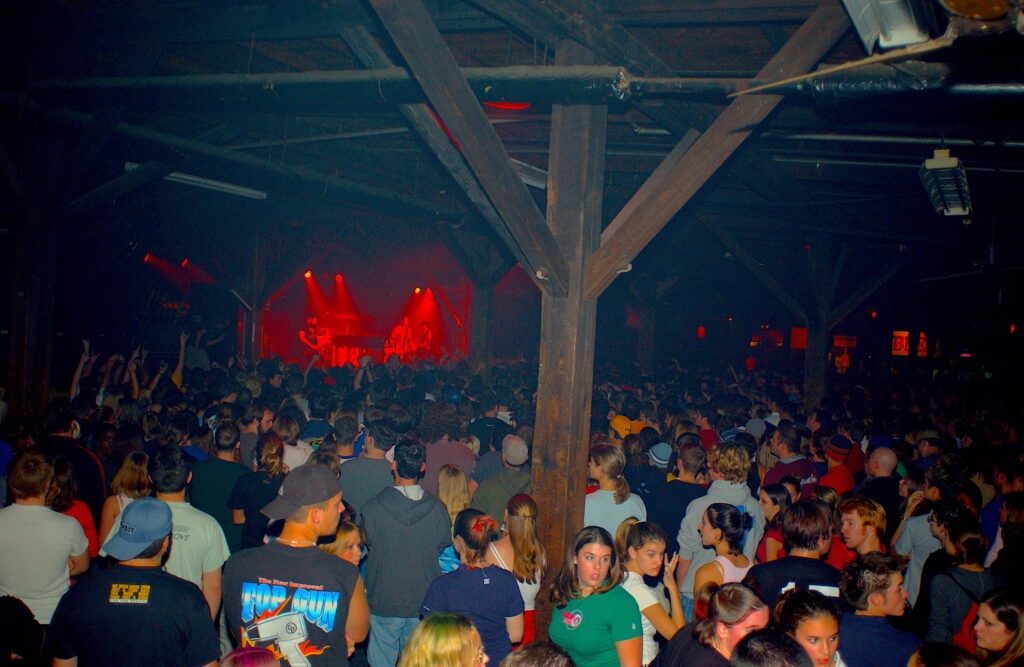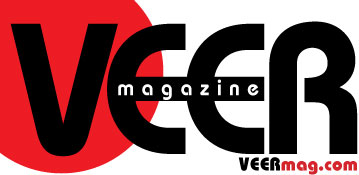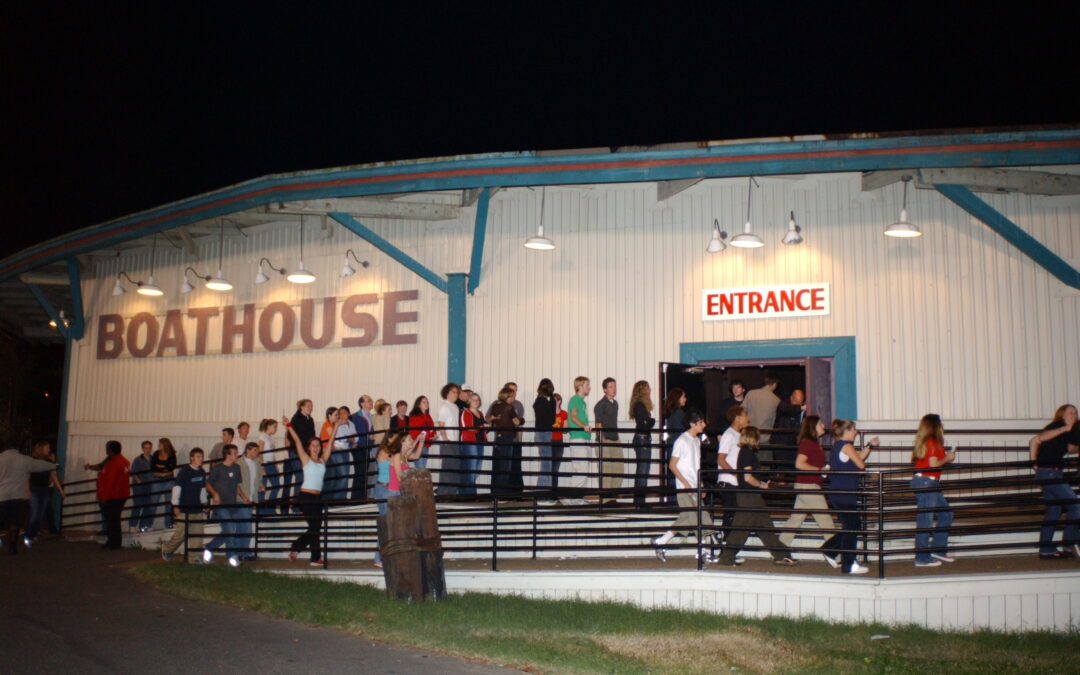(A crowd lines up to enter The Boathouse in the 1990s. Photo courtesy of Jeff Moore)
BY JEFF MAISEY
“We were backstage and there was a buffet spread out with chicken, roast beef and all kinds of good stuff,” recalled singer David Middleton, whose local band, the Waxing Poetics, opened for numerous nationally touring acts, including the Ramones, at the Boathouse during the 1980s. “Paul (guitarist) and I were starving, skinny little musicians and we were looking at the buffet, drooling. And some road manager came out and said, ‘Hey, you kids get away. That’s not for you. That’s for the Ramones.’ But then Joey Ramone came out of the dressing room, and he said, ‘No, no. Go ahead. Grab some plates; there’s fried chicken, some beans…’ He was like the classic Jewish mom making sure we got fed. And later he stood beside the stage, watched our set and shook our hands as we came off the stage. That was such a great experience to have as your first opening band experience.”
Seems everyone has a story to share about the Boathouse — of favorite concerts, personal tales and future mates met.
The waterfront concert venue, located in downtown Norfolk on the Elizabeth River next to Harbor Park, was celebrating its twentieth anniversary in 2003 when Hurricane Isabelle crashed the party, ripping fifty-percent of the roof off and caused some of the support pilings to shift.
Neither the city of Norfolk, the property owner, nor Clear Channel, the entertainment company renting the building at the time, felt the million dollar-plus estimate to repair the Boathouse was worth the investment. So, ironically, the storied career of the Boathouse, as a concert hall, ended almost as it began.
The area where the Harbor Park baseball stadium and the Boathouse now occupy was once owned by the railroad. The Boathouse was originally a freight terminal. Trains cars would deliver and receive shipped goods through the Boathouse.
As times changed and more items were being transported by trucks over land, the Boathouse became idle. Peck Equipment Company acquired the property in a land trade agreement with the railroad. Owner Stanley Peck, while trying to determine what to do with the land, spied something on the river.
“Off in the corner, one day, I noticed this dilapidated building, and I thought we ought to tear that down; it looks like it couldn’t serve much purpose,” said Peck. “But when I went in the building, I was really taken aback by how charming it was. Of course, it needed some repairs but it just had some kind of ambience to it. It looked to me like it could be some kind of destination.”
In those days, the premiere entertainment-booking agent in Tidewater was Whisper Concerts. Peck said he made several attempts to reach Whisper owner Billy Douthat, but his calls were never returned. That’s when an employee of Peck’s approached upstart Cellar Door Productions.
“When Jeffrey Lefcoe called me, he said there is this place on the water and you need to see it,” said Kathie Moore, who handled the local and regional band department of Cellar Door. “And me, not being the person who did the nationals, I passed that word on to Bill Reid.”
Reid, who would later go on to open numerous venues including The NorVa and Elevation27, grabbed Bobby Melatti and the two Cellar Door employees went down to assess the vacant structure.
“We walked in and here was this old wooden structure and you had to walk around the holes in the floor,” said Melatti, who served as the stage/production manager at the Boathouse. Melatti is now director of Beachevents. “We stood up against one of those pilings that holds the ceiling up and we looked at each other and said, ‘This place is magic.'”
The two parties soon formed a partnership where Cellar Door booked the entertainment and produced the shows and Peck’s company managed the property.
Originally, the Boathouse floor was nothing but wood planks like you’d see on a pier. Cement trucks were brought in to lay a more stable surface on top of the wood.
Jerry Meltsner, who today owns No Frill Grill and Dog ‘n’ Burger, was hired by Peck to run the foodservice end of the business. His management duties would expand outside the sheet metal shack.
“It was a dirt parking lot back then and we used to have this old 1939 fire engine that we used to drag a piece of fence with bricks on it to get the parking lot smooth enough for people to park,” said Meltsner. “The pot holes were big enough to swallow a Volkswagon.”

(A capacity audience was typical of The Boathouse’s popularity. Photo courtesy of Jeff Moore)
Dee Larion, currently executive marketing director of Live Nation in Virginia, remembers selling the first ticket to the venue’s 1983 debut show — the Skip Castro Band and Nighthawks. But the concert that put both the Boathouse and Cellar Door on the map was Tina Turner, in the summer of 1984.
Larion said the Boathouse was the place everyone played on their way up and on their return entry from stardom. Tina Turner had been an immensely popular R&B artist when she and husband Ike were together. But that had been long before Cellar Door booked Tina as a solo act at the Boathouse.
“A friend of mine, who’s an agent, said, ‘Tina Turner’s releasing a rock record and the guys from The Fixx are playing on it,’” said Reid. “I took a big chance and booked Tina in the middle of summer. The record, “What’s Love Got to Do With It,” came out, and when she played The Boathouse, it was number one in the country.”
Reid said Turner hated the Boathouse because “it reminded her of all those days when she played as Ike & Tina Turner in those roadhouse places.”
Meltsner, though, had fond memories of her. “Tina Turner was an unusual show because there were seats put down, which they normally don’t,” he said. “In my experience, Tina Turner said, ‘Honey, you’d make me the happiest woman in the world if you’d just get me a full-length mirror.’ So we ran out to K-Mart and got a cheap mirror and stuck it on the wall so she could see her whole body before she went out. The dressing rooms weren’t even done then. That show gave us validity that it (the Boathouse) was going to be more than a local band room.”
Bobby Melatti, who produced every show early on, actually watched Turner from out in the audience.
“Seeing Tina Turner in the Boathouse,” said Melatti, “is just an experience that’ll never be replicated — the sweat, the heat, the summer, the beautiful legs — it was like all the stars and planets lined up on that one magical night.”
Another important concert in the early history of the Boathouse was Bruce Hornsby. The show was broadcast live across the nation on the Westward One program.
The reputation of the Boathouse was improving vastly with every show. It was being listed in national industry trade magazines as one of the top venues people liked to come to and one of the places bands most preferred to play in the entire country. This notoriety soon caused some unexpected friction at home.
“As we had it running and organized really well, the city started taking notice of the property,” said Peck. “Bob Smithwick, who at the time was the head of industrial development in Norfolk, decided it would be better in the hands of the city than it would be in our hands. He started making moves that he was going to condemn the property and take it for the city. We were really disappointed because we didn’t want to sell it. We thought it had a great long-term future.”
The city paid Peck a fair price for the entire area, which included Bessie’s Place, the farmer’s market next to the Boathouse; both were Peck creations.
Peck said Reid negotiated a deal with the city to allow Cellar Door to run the Boathouse as a concert hall. The city of Norfolk, at the time, was also working diligently to keep the New York Mets organization from moving the Tides to Virginia Beach. Norfolk prevailed and built a new stadium on the Bessie’s Place site, but had the baseball team selected the Beach, said Reid, the plan was to build, what would become the Virginia Beach Amphitheater, where Harbor Park sits today, thus creating one large entertainment complex.
The Boathouse endured the construction zone of the baseball stadium. The bands Cellar Door brought in began to evolve from Southern rock acts, like Molly Hatchet and Marshall Tucker, to alternative rock bands, including the Psychedelic Furs, Siouxie and the Banshees, PIL and Lords of the New Church. Everyone from Phish to Steel Pulse, Iggy Pop to Megadeath, No Doubt to Black Crowes, Gregg Allman and Jeff Beck to 311 and Dinosaur Jr performed at the Boathouse. The Connells sold over 25,000 tickets in ten shows at the Boathouse.
Selling beer, too, at the Boathouse was a big deal at the time. Peck said he met with Mayor Joseph Leaf, who gave his approval as long as it could be controlled.
“We were the first club in the country to go all ages,” said Reid. “People used to laugh about the chicken wire; eighteen and under were segregated by chicken wire.”
The chicken wire was eventually replaced with a chest-high chain link barrier. “Tool was the first band, besides The Ramones, that the barrier was ripped out of the wall,” said Larion about the force exerted by the kids in the audience.
What Ken MacDonald, who began managing the Boathouse in 1988, liked best about the club was the simplicity of the space and how close the crowd could get to the entertainers.
“Seeing a show at The Boathouse was being as close to a band as possible,” said MacDonald. “It was a great stripped down experience. There were many nights with bands like Oingo Boingo or The Violent Femmes when the bands and the audience connected in a way you rarely see at more formal venues. I can’t remember the number of times when a band would finish their planned set list and there usual encores and then come back on stage and play songs that they hadn’t played in years or cover a tune just so they could keep playing.”
The States, perhaps the most successful act from Hampton Roads in the 1980s, performed its final show at the Boathouse in August of ’84. They would reunite five years later to headline the Dave Sherry Benefit concert, the late owner of the King’s Head Inn.
According to the late States bass player Butch Germano, the Boathouse stage was the place every musician wanted to be.
“The set up was great,” he said. “They always had a great PA; they always had good monitors. Whenever the lights would come on, as hot and bright as they were, it would bring you to life. And you could play as loud as you wanted.”
Though the music industry has evolved and the way we experience live music has changed, the Boathouse gave fans the naked truth about an artist’s performance capabilities.
“After a band played there, you knew whether they were for real or not,” said MacDonald. “They couldn’t hide behind fancy light shows or big stage sets, they had to perform and entertain. Sure the stage wasn’t very high and the ceiling was too low; the air conditioning wasn’t adequate for 2,000 plus dancing bodies on an August night in Virginia, but if you were there to see Jane’s Addiction, Red Hot Chili Peppers or Faith No More you had an experience! It is ironic that the things that made The Boathouse great are what seems to have lead to its obsolescence.”
Today’s success in downtown Norfolk is the fruit born from the seeds planted, in 1983, by the Waterside, Festevents and the Boathouse.
“There was a time when there wasn’t much exciting about downtown Norfolk except the Boathouse,” said Melatti. “And look where we’ve come as a community, as a city, as a region. The memory of the Boathouse can stand proud. And all the people who worked there can be proud that, for whatever little bit that we had to do with the revitalization of a really great urban community, at the end we can stand in front of the curtain and take our bow. I think we’re all better off because there was a Boathouse.”




